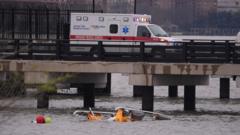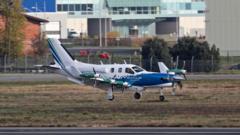The American Airlines flight crash prompts urgent analysis of aviation safety protocols.
Salvage Operation Underway for D.C. Plane Crash Victims

Salvage Operation Underway for D.C. Plane Crash Victims
Recovery teams retrieve wreckage from the Potomac as investigation continues into fatal collision.
A crane actively lifted the wreckage of American Airlines Flight 5342 from the Potomac River in Washington, commencing a major recovery operation that is projected to last three days. The salvage effort began early Monday morning, with crews and vessels steadily arriving on-site as early as 8 a.m. Eastern time. The first notable piece—what appeared to be one of the plane's engines—was successfully removed shortly after 10 a.m.
Officials from the Army Corps of Engineers disclosed on Sunday that this salvage operation is crucial as it may provide clarity on the identities of some missing victims from the fatal collision involving the jet and a U.S. Army helicopter last week. Tragically, the crash claimed all 67 lives onboard; 64 passengers from the plane and three from the helicopter. As of Sunday afternoon, authorities confirmed the remains of 55 victims have been recovered.
Once the wreckage is secured and pulled from the water, it will be transported via flatbed truck to a hangar for further examination, supplemental to a federal investigation into the catastrophe. The incident, occurring during good weather conditions as the aircraft approached Ronald Reagan National Airport, marks one of the gravest aviation disasters in the United States in the last two decades.
While preliminary aspects of the tragedy remain under analysis, the incident has sparked significant discourse concerning the operational challenges, including safety and staffing levels, at one of the busiest airports in the nation. With the investigation still in its infancy, aviation safety experts and lawmakers alike are calling for a reevaluation of protocols to prevent such tragic occurrences in the future.
Officials from the Army Corps of Engineers disclosed on Sunday that this salvage operation is crucial as it may provide clarity on the identities of some missing victims from the fatal collision involving the jet and a U.S. Army helicopter last week. Tragically, the crash claimed all 67 lives onboard; 64 passengers from the plane and three from the helicopter. As of Sunday afternoon, authorities confirmed the remains of 55 victims have been recovered.
Once the wreckage is secured and pulled from the water, it will be transported via flatbed truck to a hangar for further examination, supplemental to a federal investigation into the catastrophe. The incident, occurring during good weather conditions as the aircraft approached Ronald Reagan National Airport, marks one of the gravest aviation disasters in the United States in the last two decades.
While preliminary aspects of the tragedy remain under analysis, the incident has sparked significant discourse concerning the operational challenges, including safety and staffing levels, at one of the busiest airports in the nation. With the investigation still in its infancy, aviation safety experts and lawmakers alike are calling for a reevaluation of protocols to prevent such tragic occurrences in the future.


















